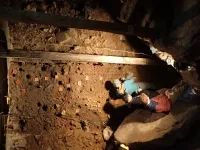Pleistocene sediment DNA from Denisova Cave
Sediment DNA tracks 300,000 years of hominin and animal presence at Denisova Cave
2021-06-23
(Press-News.org) Denisova Cave is located in the Altai Mountains in southern Siberia and is famous for the discovery of Denisovans, an extinct form of archaic humans that is thought to have occupied large parts of central and eastern Asia. Neandertal remains have also been found at the site, as well as a bone from a child who had a Neandertal mother and Denisovan father, showing that both groups met in the region. However, only eight bone fragments and teeth of Neandertals and Denisovans have been recovered so far from the deposits in Denisova Cave, which cover a time span of over 300,000 years. These are too few fossils to reconstruct the occupational history of the site in detail, or to link the different types of stone tools and other artefacts found in Denisova Cave to specific hominin groups. For example, the discovery of jewelry and pendants typical of the so-called Initial Upper Palaeolithic culture in approximately 45,000-year-old layers has prompted debates as to whether Denisovans, Neandertals or modern humans were the creators of these artefacts.
Michael Shunkov of the Siberian Branch of the Russian Academy of Sciences, who leads the excavations at Denisova Cave, assembled an interdisciplinary team of archaeologists, geneticists, geochronologists and other scientists to study this unique site. The team has now performed the largest analysis ever of sediment DNA from a single excavation site. "The analysis of sediment DNA provides a wonderful opportunity to combine the dates that we previously determined for the deposits in Denisova Cave with molecular evidence for the presence of people and fauna", says Richard 'Bert' Roberts from the University of Wollongong in Australia. The team of geochronologists led by him and Zenobia Jacobs collected more than 700 sediment samples in a dense grid from the exposed sediment profiles in the cave. "Just collecting the samples from all three chambers in the cave, and documenting their precise locations, took us more than a week", Jacobs says.
When the samples arrived at the Max Planck Institute for Evolutionary Anthropology in Leipzig, Elena Zavala, the lead author of the study, spent another two years in the lab to extract and sequence small traces of ancient hominin and animal mitochondrial DNA from this huge collection of samples. "These efforts paid off and we detected the DNA of Denisovans, Neandertals or ancient modern humans in 175 of the samples", Zavala says.
When matching the DNA profiles with the ages of the layers, the researchers found that the earliest hominin DNA belonged to Denisovans, indicating that they produced the oldest stone tools at the site between 250,000 and 170,000 years ago. The first Neandertals arrived towards the end of this time period, after which both Denisovans and Neandertals frequented the site - except between 130,000 and 100,000 years ago, when no Denisovan DNA was detected in the sediments. The Denisovans who came back after this time carried a different mitochondrial DNA, suggesting that a different population arrived in the region.
Modern human mitochondrial DNA first appears in the layers containing Initial Upper Palaeolithic tools and other objects, which are much more diverse than in the older layers. "This provides not only the first evidence of ancient modern humans at the site, but also suggests that they may have brought new technology into the region with them", says Zavala.
The scientists studied animal DNA and identified two time periods where changes occurred in both animal and hominin populations. The first, around 190,000 years ago, coincided with a shift from relatively warm (interglacial) conditions to a relatively cold (glacial) climate, when hyaena and bear populations changed and Neandertals first appeared in the cave. The second major change occurred between 130,000 and 100,000 years ago, along with a shift in climate from relatively cold to relatively warm conditions. During this period, Denisovans were absent and animal populations changed again.
"I believe that our Russian colleagues who excavate this amazing site have set the standards for many future archaeological excavations with their careful collection of many samples from each archaeological layer for DNA analysis", says Svante Pääbo who initiated the study with the Russian team. "Being able to generate such dense genetic data from an archaeological site is like a dream come true, and these are just the beginnings", says Matthias Meyer, the senior author on the study. "There is so much information hidden in sediments - it will keep us and many other geneticists busy for a lifetime."
INFORMATION:
[Attachments] See images for this press release:

ELSE PRESS RELEASES FROM THIS DATE:
2021-06-23
Humans perceive the world around them with five senses - vision, hearing, taste, smell and touch. Many other animals are also able to sense the Earth's magnetic field. For some time, a collaboration of biologists, chemists and physicists centred at the Universities of Oldenburg (Germany) and Oxford (UK) have been gathering evidence suggesting that the magnetic sense of migratory birds such as European robins is based on a specific light-sensitive protein in the eye. In the current edition of the journal Nature, this team demonstrate that the protein cryptochrome 4, found in birds' retinas, is sensitive to magnetic fields and could well be the long-sought magnetic sensor.
First ...
2021-06-23
Researchers rescued mice from early death caused by a muscle-weakening disease, not by correcting the flawed gene that causes it, but instead by targeting another protein in the same signaling pathway.
Led by NYU Grossman School of Medicine researchers, a new study found that an antibody treatment not only rescued young mice from a form of congenital myasthenia (CM) but also reversed disease relapse in adult mice.
Published online in the journal Nature on June 23, the study revealed new details of the cause of CM, with the better understanding guiding ...
2021-06-23
ITHACA, N.Y. - Scientists at Cornell University and the American Museum of Natural History have identified 2,034 nearby star-systems - within the small cosmic distance of 326 light-years - that could find Earth merely by watching our pale blue dot cross our sun.
That's 1,715 star-systems that could have spotted Earth since human civilization blossomed about 5,000 years ago, and 319 more star-systems that will be added over the next 5,000 years.
Exoplanets around these nearby stars have a cosmic front-row seat to see if Earth holds life, the scientists said in research published June 23 in Nature.
"From the exoplanets' point-of-view, we are the aliens," said Lisa Kaltenegger, professor of astronomy and director of Cornell's Carl Sagan ...
2021-06-23
What The Study Did: Hospital employees were surveyed about symptoms such as a rash, itching, hives or swelling around the face after receiving a messenger RNA COVID-19 vaccine.
Authors: Lacey B. Robinson, M.D., M.P.H., of Massachusetts General Hospital in Boston, is the corresponding author.
To access the embargoed study: Visit our For The Media website at this link https://media.jamanetwork.com/
(doi:10.1001/jamadermatol.2021.2114)
Editor's Note: The article includes conflicts of interest and funding/support disclosures. Please see the article for additional information, including other authors, ...
2021-06-23
BOSTON - Skin problems such as itchiness, rashes, hives and swelling can occur in some individuals after receiving a COVID-19 vaccine, but it's not clear how common these reactions are or how frequently they recur with a subsequent vaccination. Research by led by allergists at Massachusetts General Hospital (MGH) now provides encouraging indications that the reactions are rare, and that even when they do occur with an initial COVID-19 vaccination, they seldom recur after receiving a second vaccine dose.
For the study, which is published in
JAMA Dermatology, a team led by Kimberly G. Blumenthal, MD, MSc, co-director of the Clinical Epidemiology Program within MGH's ...
2021-06-23
What The Study Did: Researchers investigated the association between counties that adopted state mask mandates in Kansas with COVID-19 cases, hospitalizations and deaths.
Authors: Donna K. Ginther, Ph.D., of the University of Kansas in Lawrence, is the corresponding author.
To access the embargoed study: Visit our For The Media website at this link https://media.jamanetwork.com/
(doi:10.1001/jamanetworkopen.2021.14514)
Editor's Note: The article includes funding/support disclosures. Please see the article for additional information, including other authors, author contributions ...
2021-06-23
What The Study Did: The hours worked and patterns of work activities among U.S. physicians before and during the COVID-19 pandemic were examined in this study.
Authors: Xiaochu Hu, Ph.D., of the Association of American Medical Colleges in Washington, D.C., is the corresponding author.
To access the embargoed study: Visit our For The Media website at this link https://media.jamanetwork.com/
(doi:10.1001/jamanetworkopen.2021.14386)
Editor's Note: Please see the article for additional information, including other authors, author contributions and affiliations, conflict ...
2021-06-23
What The Study Did: Researchers examined family voucher-based kidney donations and the capability of voucher redemption to provide timely kidney transplants.
Authors: Jeffrey L. Veale, M.D., of the University of California, Los Angeles, is the corresponding author.
To access the embargoed study: Visit our For The Media website at this link https://media.jamanetwork.com/
(doi:10.1001/jamasurg.2021.2375)
Editor's Note: The article includes conflict of interest disclosures. Please see the article for additional information, including other authors, author contributions and affiliations, conflict of interest and ...
2021-06-23
Migratory birds carry most seeds in the wrong direction to help plants cope with climate change, new research shows.
The study, published in Nature, reveals that the vast majority of plants from European woodlands are dispersed by birds migrating to warmer latitudes in the south, while far fewer are dispersed by birds migrating north.
As a consequence of global warming, the optimal climatic conditions of species are moving towards cooler latitudes, forcing the redistribution of life on Earth.
Mobility allows many animals to reach new areas with a suitable climate.
However, movement of plant species depends on the dispersal of their seeds at long ...
2021-06-23
CHAPEL HILL, NC--Researchers at the University of North Carolina at Chapel Hill and the UNC Lineberger Comprehensive Cancer Center have uncovered a new mechanism that activates specific genes, leading to the development of cancers.
They showed that a mutation that fuses two unrelated genes can promote a process similar to that observed when oil and water are mixed but do not blend together. The process, called liquid-liquid phase separation, occurs inside a cell's nucleus and enables the formation of compartments with various physical properties that can promote cancers such as acute leukemias. Their findings will be published online June 23, 2021, in Nature.
"Phase separation and its role in cancer has been a missing puzzle piece in understanding this disease," said UNC Lineberger's ...
LAST 30 PRESS RELEASES:
[Press-News.org] Pleistocene sediment DNA from Denisova Cave
Sediment DNA tracks 300,000 years of hominin and animal presence at Denisova Cave



